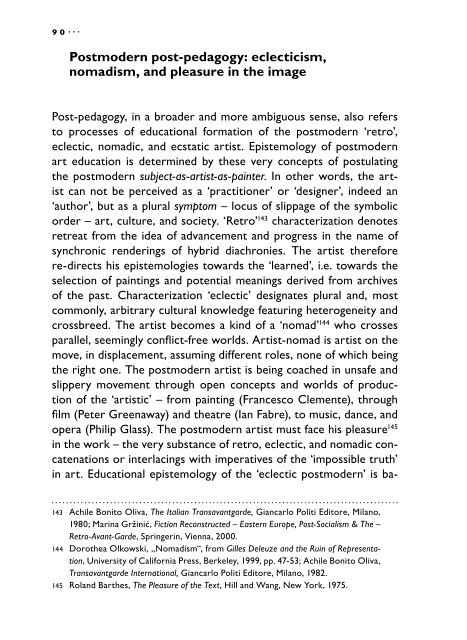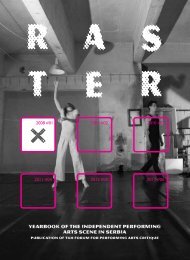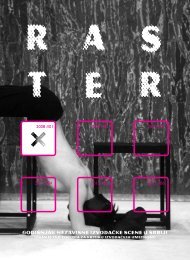Miško Šuvaković Epistemology of Art - TkH
Miško Šuvaković Epistemology of Art - TkH
Miško Šuvaković Epistemology of Art - TkH
You also want an ePaper? Increase the reach of your titles
YUMPU automatically turns print PDFs into web optimized ePapers that Google loves.
90··· ··· 91<br />
Postmodern post-pedagogy: eclecticism,<br />
nomadism, and pleasure in the image<br />
Post-pedagogy, in a broader and more ambiguous sense, also refers<br />
to processes <strong>of</strong> educational formation <strong>of</strong> the postmodern ‘retro’,<br />
eclectic, nomadic, and ecstatic artist. <strong>Epistemology</strong> <strong>of</strong> postmodern<br />
art education is determined by these very concepts <strong>of</strong> postulating<br />
the postmodern subject-as-artist-as-painter. In other words, the artist<br />
can not be perceived as a ‘practitioner’ or ‘designer’, indeed an<br />
‘author’, but as a plural symptom – locus <strong>of</strong> slippage <strong>of</strong> the symbolic<br />
order – art, culture, and society. ‘Retro’ 143 characterization denotes<br />
retreat from the idea <strong>of</strong> advancement and progress in the name <strong>of</strong><br />
synchronic renderings <strong>of</strong> hybrid diachronies. The artist therefore<br />
re-directs his epistemologies towards the ‘learned’, i.e. towards the<br />
selection <strong>of</strong> paintings and potential meanings derived from archives<br />
<strong>of</strong> the past. Characterization ‘eclectic’ designates plural and, most<br />
commonly, arbitrary cultural knowledge featuring heterogeneity and<br />
crossbreed. The artist becomes a kind <strong>of</strong> a ‘nomad’ 144 who crosses<br />
parallel, seemingly conflict-free worlds. <strong>Art</strong>ist-nomad is artist on the<br />
move, in displacement, assuming different roles, none <strong>of</strong> which being<br />
the right one. The postmodern artist is being coached in unsafe and<br />
slippery movement through open concepts and worlds <strong>of</strong> production<br />
<strong>of</strong> the ‘artistic’ – from painting (Francesco Clemente), through<br />
film (Peter Greenaway) and theatre (Ian Fabre), to music, dance, and<br />
opera (Philip Glass). The postmodern artist must face his pleasure 145<br />
in the work – the very substance <strong>of</strong> retro, eclectic, and nomadic concatenations<br />
or interlacings with imperatives <strong>of</strong> the ‘impossible truth’<br />
in art. Educational epistemology <strong>of</strong> the ‘eclectic postmodern’ is ba-<br />
143 Achile Bonito Oliva, The Italian Transavantgarde, Giancarlo Politi Editore, Milano,<br />
1980; Marina Gržinić, Fiction Reconstructed – Eastern Europe, Post-Socialism & The –<br />
Retro-Avant-Garde, Springerin, Vienna, 2000.<br />
144 Dorothea Olkowski, „Nomadism“, from Gilles Deleuze and the Ruin <strong>of</strong> Representation,<br />
University <strong>of</strong> California Press, Berkeley, 1999, pp. 47-53; Achile Bonito Oliva,<br />
Transavantgarde International, Giancarlo Politi Editore, Milano, 1982.<br />
145 Roland Barthes, The Pleasure <strong>of</strong> the Text, Hill and Wang, New York, 1975.<br />
sically ‘right-leaning’ and ‘neo-conservative’ preference for the latecapitalist-media-culture<br />
‘Romantic artist’. It is contradictory and its<br />
contradictions obscure its aesthetical and cultural potential, which<br />
should be apprehended by way <strong>of</strong> transformation – into the constructed<br />
world <strong>of</strong> images’ images.<br />
In the postmodern (transavantgarde 146 , neo-expressionism 147 , anachronism<br />
148 ) painting is defined as visual speech (rhetoric, citation, collage,<br />
montage, simulation) on models <strong>of</strong> representation and expression<br />
<strong>of</strong> symbolic, archetypical, narrative, and allegorical topics <strong>of</strong> the<br />
Western history <strong>of</strong> art (Renaissance, Manirism, Baroque, Classicism,<br />
Romanticism, Symbolism, Futurism, metaphysical painting – but also<br />
alchemy, magic, occultism, eroticism, perversion, travesty). Postmodern<br />
painting is an eclectic attempt at restoration, but also <strong>of</strong> parodying<br />
and deconstruction <strong>of</strong> the grand mimetic historical painting <strong>of</strong> the<br />
West, or heroic authenticity <strong>of</strong> expressionist modernism – stipulating<br />
the transcendental shift from pictural to invisible (death, sexuality, politics,<br />
religion). The post-historical eclecticism <strong>of</strong> the late 70s and early<br />
80s is not a true renewal (recycling) <strong>of</strong> several mutually incompatible<br />
sources <strong>of</strong> Western art, but rather modulation (in terms <strong>of</strong> expression)<br />
and relativisation (in philosophical-historical terms) <strong>of</strong> modern<br />
art institutions. Eclectic representation <strong>of</strong> the routes to the origins <strong>of</strong><br />
Western art was not established for the sake <strong>of</strong> the origins, but for the<br />
sake <strong>of</strong> domination and hegemony <strong>of</strong> modernism.<br />
The postmodern eclectic promise <strong>of</strong> a transcendental turn is, paradoxically,<br />
realized as pleasure in sense, but also as pleasure in the very<br />
act <strong>of</strong> painting in all its erotic or auto-erotic overdeterminations. Skin<br />
146 Achile Bonito Oliva, The Italian Transavantgarde, Giancarlo Politi Editore, Milano,<br />
1980; Transavantgarde International, Giancarlo Politi Editore, Milano, 1982; see also<br />
Avantguardia Transavantguardia, Electa Milano, 1982.<br />
147 „Zwischenbilanz II – Neue deutsche Malerei“, Kunstforum no. 68, Köln, 1983; Donnald<br />
Kuspit, „Flak from the ‘Radicals’: The American Case Against Current German<br />
Painting“, from Brian Wallis (ed), <strong>Art</strong> After Modernism: Rethinking Representation,<br />
The New Museum <strong>of</strong> Contemporary <strong>Art</strong>, New York, 1986, pp. 137-152.<br />
148 Branka Stipančić (ed), Anakronisti ili slikari memorije, Galerija SKC Beograd – Galerija<br />
suvremene umjetnosti Zagreb, 1984.







